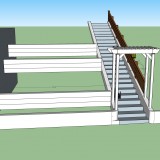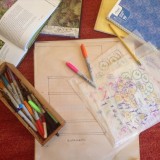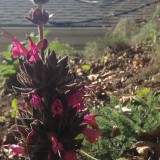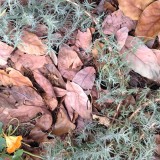
Our front yard a couple of weeks ago. This is a “before” picture.
Recently we posted my enthusiastic review of Planting in a Post-Wild World by Thomas Rainer and Claudia West. In it, I mentioned that I was using this book to help guide the redesign of our front yard, and promised to post about that process.
In the hope that our process might be of some use to somebody considering their own landscaping, I’m following through on that promise. In a more selfish way, I like to have records like this of both our actions and our thought processes, because inevitably Erik and I will forget when we did things– and sometimes even why we did them!
In the unlikely event you want to learn the history of our front yard while you drink your coffee, read on.
Considering the site
First, a brief description of the site. Our front yard consists of a garage partially embedded in a hillside, a concrete staircase of 30 stairs, and between these two things, a slope. The slope is what needs attention.
The slope is fairly small. The area under renovation measures roughly 15 feet wide by 20 feet deep, and is broken into three terraces, supported by low retaining walls made of railway ties. The bottom and top terraces are fairly flat, while the central terrace inclined perhaps 30 degrees. There is a level area around the front foundation of the house, which we’re not going to deal with in this project. There is a pomegranate tree at the top of the slope, on this flat ground, and over to one side there is a fig tree.
The slope faces east and the open street, so it gets a lot of strong morning light, and some parts of it get sun late into the afternoon, while others become shaded by noon. It also gets a lot of reflected heat from the street and sidewalk.
When we moved in way back in 1998, the slope was covered by a mat of overgrown ice plant, and at the top of the slope, where the pomegranate is now, a sickly apricot tree grew. One of the first things we had to do after we moved in was reinforce the front foundation of the house, so that the whole house wouldn’t slide down to the street during the next big earthquake or rainstorm. (Ah, home ownership!) In the process, everything in the front yard was dug up or trampled, and the soil was overturned and redistributed in violent and random ways.
We also have a little plot of land between the sidewalk and the street, as you can see in the photo above. I’m not covering that in this post. It’s hard to see in the pic, but there is a young olive tree planted there, and some native plants. That land will tie into our redesign, and I’ll talk about it when I talk about the design. But its history and development has been separate from the slope–and that’s too much to cover here.
The first plantings
After the dust of the foundation work settled, we had to figure out what to do with our barren slope. As first time homeowners new to the whole concept of landscaping, we were stumped by the problem, but dutifully read our Sunset gardening guides and determined that we should plant the slope with Mediterranean plants. Through this process we began to learn the common names of plants, as as well as their exotic, hard to pronounce scientific names, and we began to pick up on basic vocabulary: terms like root ball and perennial and massing.
We planted tough, shrubby plants like lavender and Mexican sage and lantana. We planted these around a couple of young prickly pear cactus (Ficus indica) already establishing on the slope. The workers who dug out our foundation preserved a few pads from a plant torn out during construction, and replanted them when they left. I think they knew the prickly pear is a tasty, useful plant, and they hoped we’d realize that, too.
The orchard stage
At the same time we were doing this front yard project, we were planting our first vegetable bed in the back yard, and we soon caught the homegrown food fever, and as the years passed we added more beds and colonized areas for growing edibles in almost every possible nook and cranny. Eventually, the front slope was the only place we weren’t growing food or herbs or medicinals–unless you counted the lavender.
We wanted more fruit trees, but didn’t imagine we had room for more than the couple we already had until we learned about the concept of backyard orchard culture from Dave Wilson Nursery. This was around 2008. We decided to go radical–placing food production above any concern for traditional landscaping–and planted a mini-orchard of fruit trees on the front slope, tearing out most of the original plantings in the process.
In addition to the fruit orchard, by that time we also had a prickly pear cactus growing toward the bottom of the slope–the survivor of the two planted by the workers after our foundation work. We’d learned to love its young pads and its fruit, so we left it in place and planted the fruit trees all around it.
Climate change? Bad soil? Incompetence?
With the exception of the pomegranate we planted at the top of the slope, the front yard orchard never really thrived. We studied books about organic orcharding for clues, without results. The soil on the slope had been mulched since we’d done our first plantings, and the soil had a nice organic layer from that mulch breaking down over many years. We had a good drip irrigation system, and we gave the trees compost and even resorted to amendments, but the trees never seemed happy. Some produced fruit for a year or two, then ominously stopped. Others never produced fruit. Our poor quince–which Erik had such high hopes for– never topped four feet. It looked Charlie Brown’s Christmas tree, with one or two annual fruits weighing down its five spindly branches.
We has chosen all the trees by their chill hours–meaning they should have been adapted enough to our warm climate to produce fruit, but it has been getting warmer and warmer here in the last few years. It is possible that they were simply not getting enough cold hours to fruit. Or maybe the persistent heat and dryness was just too much for them–they were, after all, stone fruits and a quince, all of which tend to like more temperate climates. The only trees which have been doing well are what I call our “Biblical trees”: the fig, the pomegranate, and the olive–trees well adapted to hot dry lands.
Still, we kept hanging on, giving the trees more time, hoping they’d find their way to health.
Our waiting turned into denial and avoidance. The truth was the yard was not happy or healthy, and we just shut our eyes to it every time we came home, and tried not to think about it. The indomitable Mexican sage and lantana reasserted themselves from root bits left in the soil and threaded their way among the straggly trees. The slope looked alive, but it did not look loved.
It’s hard to admit to making a mistake, particularly when its a costly mistake, or a mistake that you’ve made publicly, or a mistake that you’ve been making for a long time. This is why people keep climbing Everest even when they see a storm is rolling in. This is why we ended up with an ugly yards full of struggling trees.
The cactus, however, grew exponentially. Its position was front and center of the slope, so–for better or worse–it blocked the view of the rest of the yard from the street. For several years it was very handsome, and we enjoyed eating and sharing the pads and fruit. I think people who walked by our house thought of it as the “cactus house.” Whenever I was out front, I’d hear people commenting on the size of it as they passed.
But eventually, it got to be too big. Prickly pears are no fun to prune. Those pads are big and surprisingly heavy. Imagine a tree made up of interlocking watermelons and you’ll have some idea. Watermelons covered with lethal spines, that is. And gloves do not stop prickly pear spines. Gloves merely collect the spines, and then your gloves are ruined forever.
We put off pruning it one year too many, and suddenly, this year, we realized we couldn’t harvest any of the fruit, because it was all growing too high to reach. So the fruit would rot up at the top, then fall to the ground to attract flies. Meanwhile, the heavy branches were beginning to stretch over the sidewalk, threatening passersby. It was also blocking light to the fruit trees–not that it mattered much at that point.
A slight shift in philosophy
As all this was going on, Erik and I were gradually shifting in the way we though about our home landscape, and really, our relationship to the world as whole. While we enjoyed vegetable gardening, we decided we didn’t need to do so much of it. It began to seem competitive and extractive. By extractive I mean we found it hard to give back to the soil as much as we were removing. It was hard to make enough compost. We were relying on outside sources more than I liked.
One of those resources was water–lest I forget to mention it, we’re in the fourth year of a severe drought. Living through a drought like this will change a lot about the way you think.
We became more interested in working on a yard that served life at many levels–not just us. To be clear, we’d always considered such things, and written about them–we advocated mulching and keeping a good relationship with weeds. We had wild spaces in our yard, and we let our veggies flower and seed so to support insects and birds.
Perhaps it’s simplest to say that our hearts changed. We wanted to actively serve the whole. It was no longer enough to give an intellectual nod to diversity, or make a few gestures.
Feeding pollinators and birds and lizards and the soil critters became more interesting, and more engaging as a challenge, than feeding ourselves. Which is not to say we’d ever stop growing vegetables entirely–no way! But we began to imagine a yard which was utterly inclusive and diverse, and at the same time, more self-supporting. I wanted to bring home what I’ve been calling the Loving Landscape. I just wasn’t quite sure what that would look like. And so we spun our wheels.

Our yard was looking like Grey Gardens. And I’m about one fur coat away from looking like this lady.
Realizing it was time to give up
After a few years of this slow decay, we had to wake from our denial and admit that these trees were not going to improve, and that the whole front yard was an aesthetic disaster. The huge cactus, which had hid so many of our sins, was now leaning over the sidewalk and randomly dropping heavy branches to the ground. We could end up being responsible for a flattened Chihuahua.
Still, we tried to get away with doing as little as possible. We talked about pruning the cactus by half, and removing the worst trees on the slope. We planted some ground cover beneath the trees. But we had no coherent plan–we were just talking about damage control.
Then we got hold of Planting in Post-Wild World and as I read it, the scales fell from my eyes, my friends.
Suddenly, I had a vision of a cleared slope, open to the light, filled with meadow plants dancing with butterflies, bees and hummingbirds. Erik saw my vision, and we set to work chopping down trees.
As I wrote in another post, in the end, it was not emotionally difficult to remove the stagnant trees. They seemed to want to go. The cactus was more difficult to remove, as it was, undeniably, thriving. We made a deal with it–we moved a few pads to another place up at the side of our house. If it stays true to form, it will root easily and start growing like gangbusters. This way its genetic legacy will live on, and we can still have its fruit and pads to eat. And if we’ve learned our lesson, we’ll keep it small this time. As I write, there is literally about a ton of dismembered cactus moldering in our driveway.
In the next post I’ll write about the process of planning our meadow garden.






I think I have said it before, but I would much rather read posts like this than just success stories. I’ve been playing with permaculture ideas for a few years. Some of them are working. Others ARE NOT WORKING. I was about to build an arbor – I have the lumber in my yard – when your arbor post went up. I looked at the squirrels and other rodents in my area and could see exactly the same thing happening and altered course.
I read through Planting in a Post-Wild world, looked around, and went “of course it is not working.” The areas of my yard that are working already followed a lot of the principles, largely by accident. The areas of my yard that are not working are because none of the principles are in place and it is just a mish-mash of plants from different landscapes. I kind of died inside when I realize that, because a lot of work had gone into it, but the truth immediately became obvious.
So, in the spring, I am going to build on what is working. Everything that is working gets new friends to create a cohesive landscape and look. Everything that got planted in my effort to create a functional fruit-tree guild that is just sitting there not doing its job is getting edited out.
Thanks! And thanks for sharing your own travails. This stuff has a big learning curve, that’s for sure. Your plan for the spring sounds good–and yep, smart call on the arbor, too. 😉
Be careful here. The Permaculture Institute (Bill Mollison) once applied for trademark protection on the word “permaculture”. The application was rejected. Sound familiar?
This is interesting; looking forward to the next post and ‘after’ pictures!
[A]nd then your gloves are ruined forever.”
A woman who had taken advantage of me in a sale offered me a plant as she could see I was angry. I chose the nicest pot which, unfortunately, held cactus. I was smart and wore leather gloves to handle it as I put it in the trash so I could use the pretty pot. Well, I was cheated twice as I had to give away those gloves. Yes, I warned the guy about the embedded cactus! But, before that, I kept gathering spines in my fingers for months. That cost me another $12 for new gloves.
I became frustrated with two trees who were not happy in the places I chose for them. One was cut. I offered the pink dogwood to someone if they would dig it up AND bring dirt to fill in the hole. Getting those two trees out of my sight was a freeing experience. The woman who got the pink dogwood said it was happy in her yard. These trees were an expensive mistake for me that I allowed to linger for too long.
The one I cut just would never stand up. It leaned and took up about 15 feet of the back yard. I know it was planted correctly because I supervised the planting.
After my grape arbor (9×18 ft) quit producing that in the 30 years I have lived here, the neighbor’s maple tree grew over my yard, virtually blocking all sunlight from the arbor. Now, with the trees I planted, the whole side yard where the grape arbor is located is in full shade along with the front and other side yard. Sad!
Ahh, the joys of realizing your plan for the front yard did not account for the vigorous growth of one plant and the death of another. I can relate. Our non-fruit producing flowering quince have taken over our front step and probably need to be ripped out because of the runners that are getting sent everywhere. Three years of growth is down the toilet or into the compost cart, as it were.
BTW, when did the garage get a new roof? I thought it used to be a flat roof.
Huh. That’s funny that you know that. We did have a flat roof on the garage when we first moved in, but we’ve had a peaked roof for many years now, at least 10 years. (We had to shore up the garage as a part of the project to keep the house on the hill, and the flat roof leaked.) Sorry about your crazy quince!
I agree with the first commenter – great to see a post like this about what went wrong. It’s funny how emotionally attached we get to things in life that are clearly not working, and we let that blind us. I’ve tried to force many gardening projects that simply were not meant to be, because I was emotionally and financially invested. Knowing when to walk away opens up new possibilities, like your meadow! Interested to see what’s in it – wondering if you will go native only, any edibles, etc.
Thanks, Christine. Good to know we’re not alone!
Yes, I thought you had a solar dehydrator on top of the garage. Do you still have it? And good that you know how to use those prickly pear cacti. I have heard that lots of layers of newspapers can be used to move them or pick them up. Maybe you can show a video on how to get the thorns off? I love the pads but just buy them from the Mexican market.
We are anxious to see your after photos and what your choice of new plants will be.
Yes, we still do have the dehydrator on the garage roof. Paper is a good means for moving prickly pear, yes! We’d love to show you how to “dress” a prickly pear, but sadly we’ve just cut ours down! I’ll try to keep it in mind this spring when the fresh pads come out–maybe we can steal one from a neighbor. Erik is such a prickly pear partisan that I’m sure he’d be happy to make that video.
What’s with sickly apricot trees in Los Angeles? When we moved in to our house in L.A. in 1986 or so, there was an apricot tree. I remember apricots. Then it wasn’t too long before the tree wasn’t looking too great, and then up and died. The orange and lemon tree were fine. Nowadays the lemon tree was removed when we remodeled, and the orange tree would be happier if we gave it more water.. but I digress.
“By extractive I mean we found it hard to give back to the soil as much as we were removing. It was hard to make enough compost. We were relying on outside sources more than I liked.”
So, even with the chickens, that big worm bin plus the ginormous compost bins you have, there’s still not enough to feed the soil in your modestly sized lot? your blog inspired me to start growing squash and tomatoes last summer and was hoping someday to have a system in place where I needed hardly any inputs and just grow comfrey and do that Permaculture-style “Chop and Drop”. I don’t have chickens–yet. Maybe I’m just not understanding how complicated the whole issue of soil building is?
I totally agree with everyone else here in that I’m very interested to read about your real struggles and changes in gardening philosophies. I’ve changed my mind too many times which has resulted in patches of natives, areas of ornamentals and veggies scattered throughout. Thank you for your blog. A constantly evolving yard based on observation is what it’s all about, right? 🙂
Part of the problem with food production here is that now that we know we have lead in our soil, we have to grow in raised beds, and so we have to keep adding soil and/or compost to them. If we could grow in the ground, we’d be a lot better off.
In general, the worm bin is a good size and is really helpful for producing loads of castings. In terms of compost, it is hard for us to get enough input materials without turning to outside sources. Our yard is just too small–most of our inputs are seasonal, linked to cleaning up the garden, so that means we can maybe make two batches a year under a closed loop system, and that is really not enough to cover all the hungry beds and the (former) fruit trees. If we had more space, or perhaps I should say more untainted space, we could grow compost crops like comfrey. It’s particularly tricky with the lead in the soil, because we really can’t pull stuff from the ground and add it to the bin–we’d end up adding lead, via the compost, to the raised beds. So all inputs have to come from the kitchen or the beds themselves–or the outside.
Glad you find this useful–thanks!
Going through the same thing here in the west end of the San Fernando Valley. Tearing everything up in the front yard. I thought cutting healthy plants would be painful, but it was indeed freeing. We also have two ginormous prickly pears in the back that I’ve struggled with getting rid of as they have such history on this property. One has an infestation now so that has allowed me to give myself permission to take them out… soon… when I get a little braver… and when I get better gloves…. Can’t wait to see the after photos of your yard.
Pingback: Limbo, Mistakes, Intentions, Frustration, and Finally, Some Farm Talk – A Rambling Post | the barefoot budget
Holy Italian Cypress! It would be cool to do mini terraces with dry stack stone or salvaged broken concrete and direct and contain the stormwater flow (if it ever rains there again)in a permaculture (no trademark) rainwater harvesting sort of way down the slope to water those wildflowers you are dreaming of. (=
Ha! I just wrote about that in the new post. It’s a beautiful idea. We did consider using “urbanite” as a retaining wall material. Your water collection idea is a great spin. In the end, though, we decided that we’d take the easy way out. We’ll see how that works out when the rains come. 🙂 We’re finding it a lot harder to take on heavy lifting projects now that we’re 50ish than we did when we first moved in and we were 30ish! (“Oh my back!” “Oh my feet!” &etc.)
Oh yeah, and the neighbors’ cypresses are indeed monumental!
Pingback: Our new front yard, part 2: theory | Root Simple